
The Levi Jordan Plantation.
http://www.webarchaeology.com/. Carol McDavid.
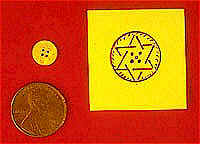 |
Carved shell with Kongo pattern.
From the Levi Jordan
Plantation Web site.
|
The Levi Jordan Plantation Web site is an ambitious
undertaking that explores the lives of the men and women who
lived and worked on the Levi Jordan Plantation in Texas from the 1840s to the 1890s.
Intended for a general audience and envisioned as a forum for community participation in the telling of history, the site nevertheless has difficulty escaping the heavy hand of the academic scholars leading the project.
Much of the site focuses on the on-going excavations of the plantation's slave and tenant cabins. Artifacts unearthed at the location of four particular cabins suggest that the residents of these dwellings had distinct roles: blacksmith, political leader, curer/conjurer, and shell and bone carver. Several of the objects provide evidence of African traditions. A carving from the curer's cabin matches the Kongo sign of cosmos, and the fly whisk uncovered at the political leader's residence resembles symbols of authority traditionally found in West Africa.
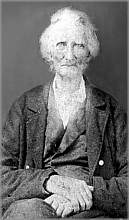 |
Patriarch Levi Jordan.
From the Levi Jordan
Plantation Web site. |
The site contains other "voices" in addition to archaeology. An illustrated history of the plantation derived from tax books, courthouse records, and Jordan family papers provides context for the archaeological findings, as does the analysis of forces shaping the transition from slavery to tenancy. Oral histories gathered from elderly residents of communities near the plantation complement the curer's cabin findings with accounts of traditional healing and birthing techniques. Furthermore, researchers have used census records, account books, and oral histories to establish a strong pattern of continuity over the 50-year period. Many men and women who lived as slaves on the plantation remained there as tenants well into the 1890s.
Although the site's findings are interesting, the presentation is not without its problems. To begin with, a less text-oriented approach would have been more inviting to the general public. The domination of essays, interviews, and papers—illustrated only by small, low-quality photographs—makes the site aesthetically unappealing.
Moreover, much of the writing tends to be too academic for a general audience. Although some of the essays appear to have been prepared exclusively for the Web site, others are abstracts of conference presentations and dissertation proposals.
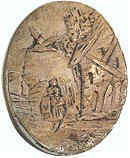 |
Carved shell "cameo."
From the Levi Jordan
Plantation Web site. |
The reliance on scholarly narration also limits the site's appeal to a general audience because it closes off the opportunity for the kind of free, open-ended inquiry that the Internet has made possible for non-specialists. The World Wide Web allows visually rich materials–such as the artifacts found in the Levi Jordan excavations—to have equal billing with traditional academic narrative. Had the designers concentrated on high-quality photographs of artifacts and made effective use of hyperlinks and searchable databases, visitors to the site would have been able to experience some of the excitement of the archaeologist in the field. Instead of being told that the carving uncovered in the curer's cabin is similar to carvings found in Africa, for example, visitors could have discovered the relationship by examining and comparing the artifacts on their own.
The site is also limited by an ineffective use of historic documents. For example, the list of plantation residents cites the records in which individuals' names were found but, with a few exceptions, leaves the actual contents of these documents to the imagination. So, although visitors learn that resident Ellen Johnson was listed in plantation account books and in the 1870 federal population census, visitors are provided with none of the rich, descriptive content that these sorts of records have to offer. Was she the head of a household? How old was she? Did she have an occupation? Even more frustrating, the list of individuals with documented African roots cites no sources�visitors are instead directed to the local public library for more information. Transcribing the records in full would have provided visitors with more concrete details about the residents' lives and, in doing so, allowed visitors to develop a deeper understanding of the experiences of plantation slaves and tenants. In addition, exploiting more fully the rich detail in these records would have facilitated the kind of open-ended inquiry that the Web has made possible.
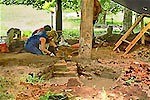 |
Site excavation.
From the Levi Jordan
Plantation Web site.
|
The Levi Jordan project aims to do more than simply explore the lives of the plantation's residents.
The site also has the stated goal of helping "people learn more about how people communicate over the Internet about history and archaeology." It seeks to advance this rather vague objective in two ways. First, the site provides carefully crafted explanations of how archaeologists find and interpret artifacts. Second, the site features countless invitations to join discussions, contribute family histories, and answer on-line questionnaires. By encouraging dialogue between the general public, academic specialists, plantation descendents, and nearby residents, the designers hope to transform archaeology and history into a community enterprise.
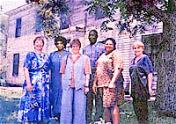 |
| Board members and officers of the Levi Jordan Historical Society. Photo from the Levi Jordan Plantation Web site. |
The invitations for community involvement, combined with the site's emphasis on slaves and tenants rather than plantation owners, suggest that the authors have a larger, if unstated, goal: to democratize the study of the past.
On the surface, the project seems well-positioned for the challenge. Archaeology, by relying on material findings rather than written records, can highlight the lives of slaves and laborers in a manner that traditional histories simply cannot. Furthermore, the inclusive membership of the Levi Jordan Historical Society, which includes university-level archaeologists, descendents of plantation owners and laborers, and residents of nearby communities, indicates a commitment to incorporating diverse concerns and points of view.
Had it been utilized effectively, the medium of the Web could have helped the designers achieve their goal of democratizing the study of the past. Yet the Levi Jordan Plantation project fails to take full advantage of the Web's potential. In particular, the authors could have used the Internet to turn traditional scholarship inside out by highlighting artifacts and documents. This approach would have served to demystify the work of the scholar and to heighten general interest in history and archaeology. Instead, however, the authors take the opposite approach by emphasizing text and scholarly analysis over the raw materials of the past.
The Levi Jordan Plantation Project, with its archaeological findings and inclusive plantation history, makes an important contribution to the World Wide Web. Although the designers may have limited the site's overall appeal by emphasizing academic papers over the artifacts themselves, the archaeological record and the story the team presents is compelling. Examining one small place over many generations, the site provides the visitor with a rich sense of change and continuity in the experiences of rural 19th- and 20th-century African Americans.
Alice Carter
Virginia Center for Digital History
~ End ~
Web Site Review of The Levi Jordan Plantation
Copyright © 1999 by The Journal for MultiMedia
History
Comments
| JMMH
Contents |




